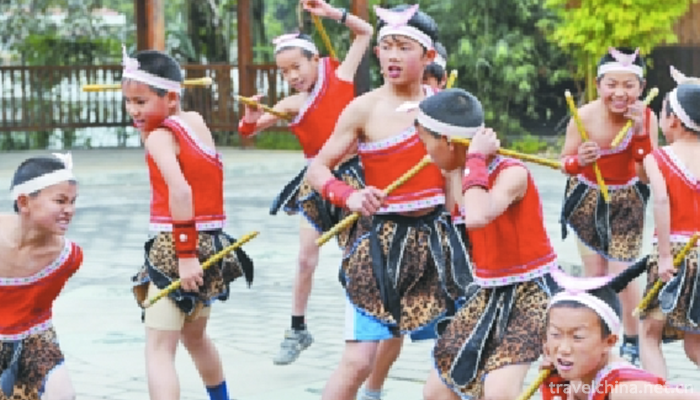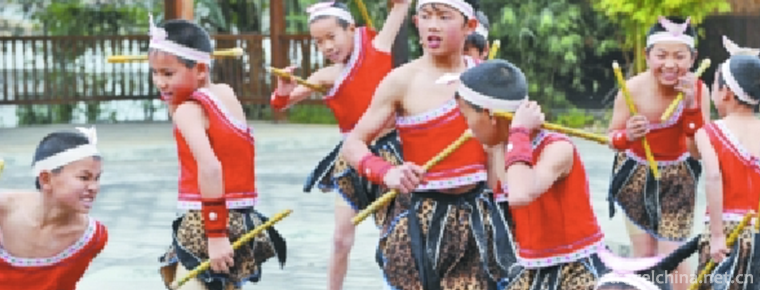Maonan people beat monkey drum
Maonan people beat monkey drum
"Monkey Drum Dance" is a traditional dance of Maonan nationality in Guizhou Province, which is used for funeral activities and performed by wizards. It is spread in some villages of Pingtang County. "Monkey drum dance" can be divided into two types: men's solo dance and double dance. The contents are divided into three parts: the birth of Monkey King, monkey's knocking on toon and monkey's fire leading way, which shows the origin, unity and bravery of Maonan nationality. Don't forget your ancestors'wishes, etc. Nowadays, monkey drum dance has become the most popular self-entertainment dance.
In June 2008, the monkey-beating drum declared by Pingtang County of Guizhou Province was listed in the second batch of national intangible cultural heritage list with the approval of the State Council.
historical origin
"Maonan people beating monkey drum" is also called "monkey drum dance". It is one of the folk dances of Maonan people, a minority nationality with less than 100,000 people in China. It originated from Jiaweng Group of Jiaba Village, Kapu Maonan Township, Pingtang County, Guizhou Province. It is a folk dance performed by wizards by Maonan people in funeral customs. It reflects the contents of witchcraft etiquette, funeral exorcism, evasion of evil and seeking good fortune, and worship of the elves. It has been handed down for more than 600 years.
Later, in order to commemorate the deceased relatives, Maonan people used animal skins to make hand drums, transforming the legends about the three brothers into a form of national dance to commemorate their deep feelings for their relatives, which became the cultural classic of Maonan people - "monkey inspiration". In addition to sacrificing the deceased relatives with bronze drums, Maonan people have to use monkey drums to express their nostalgia for the deceased relatives. Because of their happy rhythm and funny movements, they gradually evolved into some festivals of Maonan people and became the traditional dance of Maonan people.
artistic characteristics
Maonan folk dance is mainly spread in Maonan Township of Kapu, Liudong and Hezhong of Zhimi Township. The representative programs are "beat monkey drum", "blocking door song and dance", "torch festival", "Deya cattle" and so on. The dance of "beating monkey drum" is mainly used in funeral ceremonies. It is divided into three parts: The Birth of the Monkey King, The Monkey Knocks on the Pile and The Monkey Leads the Way. One person beats the bronze drum, one beats the skin drum and three perform. The performance time can vary according to the mood of the performer. "Barrage song" is a kind of etiquette performance organized by the man's family to welcome his wife into the house. It sings with accompaniment, beats her around with a brown fan to show dust removal, and wears a rotten hat on her head to show cool, improvisation and humor. "Torch Festival" is the Maonan people lighting with torches on New Year's Eve, beating gongs and drums, bragging horns and trumpets, suona, in groups up the mountain "cursing" and "capturing captives". The whole activity was improvised, with one person dancing and singing, and two or more people dancing. It was very lively.
Inheritance significance
The Maonan Drum for Fighting Monkeys is one of the unique folk dances of the Maonan nationality in China. Originated from Jiaweng Formation of Jiaba Village, Kapu Maonan Township, Pingtang County, Guizhou Province, it is a folk dance performed by wizards by Maonan people in funeral customs. Dance combines witchcraft sacrificial act with religious and legal act, which has distinct national and local cultural characteristics and outstanding folk traditional cultural space.
The dancing movements are bold, smart, simple and vigorous. They reflect the precious national spirit and the desire of Maonan people for a better life. They also reflect the folk customs and totem consciousness of Maonan people. They are the living fossils for the study of Maonan national culture and customs.


-
1.Mount Jiuhua Scenic Area
Jiuhua Mountain Scenic Spot is located in Anhui Province, China. The northwest is across the Yangtze River and Tianzhu Mountain, and the Southeast
Time 2018-12-08 -
2.wunv mountain city
Wunu Mountain City is a national key cultural relic protection unit. It was built by Zhu Meng, the ancestor of Koguryo. The three gates of the city are narrow at the bottom of the wall
Time 2018-12-22 -
3.Bao Xiaosu Temple
Baoxiao Sugong Temple, abbreviated as "Baogong Temple", is located on a mound in the east section of Huancheng South Road, Hefei City, Anhui Province. It is the main ancient building complex
Time 2018-12-26 -
4.Island Jinshan Temple
Jinshan Temple, located in the northern part of Qingyun County, Dezhou City, Shandong Province, was built in the Sui Dynasty and flourished in the Tang Dynasty. It is said that the island Jinshan Temp
Time 2019-01-13 -
5.The legend of Huang Daxian in Huangchuping
Huang Chuping's legend is one of the local folklores in Jinhua, Zhejiang Province. It originated in the Eastern Jin Dynasty. The earliest written record was in The Biography
Time 2019-05-04 -
6.Beach Head Wood Engraving New Year Pictures
Tantou woodcut New Year's picture is the only handmade woodcut watermarking New Year's picture in Hunan Province. It has its own style with strong local characteristics in southern Chu. Tantou Town is
Time 2019-06-18 -
7.Centipede dance
Centipede dance, Guangdong traditional folk dance. Originated from Tongzhi in Qing Dynasty to Guangxu, it was initiated by Chen Chengjin, a native of Ximen, and Shi Wenyong, a good friend. It is a squ
Time 2019-06-29 -
8.Panwang Festival of Yao Nationality
Panwang Festival is an important festival to worship ancestors Pangu, Pangeng and Panhu. People at home and abroad attach great importance to this national sacrifice ceremony. Launched by the Pan fami
Time 2019-07-11 -
9.Western Grand Canyon
Synonyms Western Grand Canyon hot spring generally refers to the Western Grand Canyon
Time 2020-10-16 -
10.Guangyuan climate
Guangyuan City belongs to subtropical humid monsoon climate; it is located in the southern foot of Qinling Mountains, which is a transition zone between North and south. It has the characteristics of humid climate in the South and the characteristics of high sky
Time 2020-12-15 -
11.Neijiang tertiary industry
In 2019, the investment in real estate development in Neijiang City will increase by 2.7% over the previous year. The construction area of commercial housing was 12.4341 million square meters, an increase of 8.9%. The sales area of commercial housing was 4.6939 million square meters, an increase of 8.0%.
Time 2020-12-16 -
12.Leshan secondary industry
In 2019, the industrial added value of Leshan City is 68.028 billion yuan, an increase of 8.8% over the previous year, accounting for 36.5% of the city's GDP, driving economic growth by 4.0 percentage points and contributing 52.8% to economic growth.
Time 2020-12-17